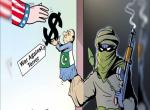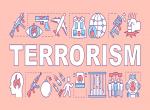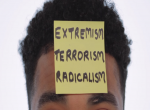The penetration of the influence of the Islamic State (IS) on the American soil has increasingly become visible over the past few months. That a few (even microscopic minority) citizens are supporting this terror group is evidence that a country, which has immense pride on its secularism and democratic values, is not anymore immune to the influencing power of this destructive outfit. Their skilful social-media propaganda campaign has been successful in radicalising young Americans of different ethnic origins. Today, with a rising number of people being arrested on the charge of having some form of connection with the outfit, it has gradually become an emerging threat to the homeland security.
Message of San Bernardino Attack
The recent attack in San Bernardino, carried out by a couple, has triggered a serious debate in the US over the increasing influence of IS amongst a few radicalised Muslim citizens. Although there is still no concrete proof of IS’ involvement in this episode, even a slight inspiration which is believed to have been drawn from this outfit (in this case) is a matter of serious concern, particularly considering the resonance it has received from several impressionable young Americans in a short duration. If any direct link with the IS comes to be established, then it also means that the outfit’s repeated calls to attack American citizens, both within and abroad, does not remain mere rhetoric. Moreover, such gruesome attack indicates a gradual escalation of terror activity inside the country, which is causing discomfort to the security establishments. Whatsoever might have been the case, both the shooters, Syed Rizwan Farook and his wife Tashfeen Malik were reportedly supporters of IS, and some reports even mentioned of the “allegiance” pledged by the latter to Abu Bakr al-Baghdadi.1 The ongoing investigation, however, should be able to unravel, sooner or later, the true motive behind this carnage. But even if it turns out to be an outcome of self-radicalisation or that of lone-wolves attacks, it definitely bears the hallmark of IS-inspired/directed activities. This is already a boost for the outfit as the shooters exhibited their adherence to the ideology. It also, simultaneously, reflects the presence of individuals, who without a direct link with the group are ready to unleash onslaughts. This may set a precedent for others with similar ambitions.
IS-related Recent Developments in the US
The emergence of IS as a strong and resolute organisation has enticed individuals and several terror organisations all over the world. The young Americans who are drawn into its ideology are no exception. The savvy social media campaign it is undertaking to lure foreign recruits continues to meet with significant success and has facilitated recruitment. The recruiters inside the US use the same tool, and they have been able to brainwash vulnerable youths, mostly the college/university drop-outs. This is the normal pattern which is followed everywhere. A study conducted by the Virginia-based Threat Knowledge Group mentions that “ISIS is recruiting within the U.S. at about three-times the rate of Al Qaeda”.2 During the recruitment drive, the Muslim converts have become the soft targets, and 40 percent of the arrestees belonged to this category. This is a significant share as 23 percent of the Muslims in America are converts.3 Youths as young as 15, 16 and 17 years old were arrested for IS-related activities, while the average age of the sympathisers/supporters is between 20s and late 40s. This fits well with the profile of those fighters who travelled to Syria/Iraq from European, African and Asian countries.
In 2015 alone, 56 individuals have been arrested, and this is the largest number in a year since September 2001, that is, the year when the terror related individuals were detained. Between March 2014 and November this year, the total IS-connected arrest stood at 71 (including the mentioned 56).4 From various analyses, it is understood that not all of them intended to carry out or plot attacks inside the country but were also interested in travelling towards Syria/Iraq to provide manpower or financial supports to the fighters there. Reportedly, 29 percent of the arrested people wanted to carry out domestic attacks, 19 percent played the role of facilitator and the remaining 52 percent were foreign fighter aspirants.5 This could perhaps be the reason why most of the arrests were made in airports, including the couple from Mississippi, 22-year-old Muhammad Oda Dakhlalla and his 20-year-old wife Jaelyn Delshaun Young. Early this year, the Federal Bureau of Investigation (FBI) reported that all the 50 American states have IS-related investigations6, but a maximum number of arrests were made in 21 states, with New York (13 cases) topping the list, followed by Minnesota (11 cases).7 In October, its Director James mentioned about 900 investigations “against suspected Islamic State-inspired operatives and other home-grown violent extremists across the country”.8 While the numbers is less than significant as compared to the Europeans, the ability to win supporters from American citizens reflects the actual magnitude of this ever expanding phenomenon.
The profile of Americans who are found supporting the outfit is quite diversified or heterogeneous, but they are not different from the recruits elsewhere. Youngsters from well-to-do families with good education background are increasingly attracted to this dreaded phenomenon because disillusionment amongst this section is rampant. Moreover, their search for ‘identity’ and ‘purposes’ have paved their ways to radicalisation and are ultimately succumbed to the ideology of the IS. This is mostly visible in the converts who have formed the core of the potential recruits in the US. The converts are vulnerable and easier targets as they still find difficulties in assimilating with the mainstream Muslim community. They “emerge as some of the most dangerous and fanatical adherents to radical Islam” and their sense of disconnect from the local mosque have been attributed towards the rising rate of radicalisation in the US and in Europe.9 For these people, who are in a limbo, the extremist ideology of the IS gives a sense of belonging as well as an alternative. Alongside these factors, the growing zeal to take revenge against the ‘infidels’, and the idea of restoring “the Caliphate that ceased to exist after the end of World War I and the collapse of the Ottoman Empire” have drawn themselves to the group.10 In other words, the radicalised and the recruits take it as a religious obligation to migrate towards Syria/Iraq and help the IS fighters in creating an Islamic state. Furthermore, the constant depiction of the brutalities meted out by Syria’s Bashar al-Assad regime against his people have motivated the youths to take part in the conflict by joining group like IS. Social media plays a pivotal role in igniting the consciences of these soft targets in the US, and this has gone in favour of radicalisation and recruitment.
In addition to this, an equally worrisome trend is the involvement of large number women in this project. This has also reflected the increasing roles for women in terror organisations, including IS, which is quite contrary to of the actual oppressions against womenfolk by its fighters. Reportedly, ten out of the 71 arrested have been women. The propaganda that depicts women as “lioness” in tandem with men to build utopian Islamic state, rejection of materialistic cultures and anger over the perceived oppression against fellow Muslims are some of the attributed factors for these women supporting the outfit.11 This is a widespread phenomenon where young girls and women are leaving their countries “for a life of adventure, religious devotion, and cloistered housework” in the group’s self-proclaimed caliphate. 12 This also reflects the rising “counterculture revolt” which is developing amongst many Muslim girls who are refusing to live as “second-class citizens” in the West. 13 Most importantly, their participation serves the interest of the outfit as they are avid users of social media and they can offer guidance to other women who are seeking to follow the path of terror. It is mainly because of this women’s role during online radicalisation and recruitment has become important.
Threat Perceptions:
The threat from IS on a particular country can be in various forms, but in the regions which are far off from the epicentre of its activities, the most imminent ones are those which emanate out of local terror groups which pledged allegiance to IS and lone-wolves attacks. The latter scenario, as witnessed in the San Bernardino attack, is more likely in the American context. However, with rising IS-related arrest, the activities of the lone-wolves are likely to remain dormant and hence increase the degree of difficultly in the surveillance efforts. The agencies are aware of this, and the FBI has not ruled out the presence of undetected IS sleeper-cells inside the country.14 Difficulty in detecting the presence of such additional individuals who can operate individually is self evidence. There is also the possibility of such people carrying out violent attacks in conjunction with other terror outfits, including IS. They are, thus, going to be a major challenge to the counterterrorism measures of the US.
The 13-November Paris attacks have indicated the potential expansion of IS’ operations abroad. The rising attention of the outfit towards the Western world has come at this juncture when the self-proclaimed Caliph repeatedly advised the foreign fighters to stay in their respective countries and target their own establishments as enemies. As US still has many IS-supporters under the surveillance, the law enforcement establishments should be prepared to meet the emerging challenges from these zealous lot. There should not be any room for complacency as such attacks by lone-wolves are not impossible anymore. As a result, any warning, even if it appears to be for propaganda purpose, should not be underestimated.
Conclusion:
It is, undoubtedly, going to be a challenge for the Barack Obama administration to prevent the growth of radicalisation and recruitment into IS. Apart from its military campaign (in Syria/Iraq), the US needs to craft effective domestic counter-narratives to fight the pernicious ideological propaganda of this outfit. For that, it must have an inclusive policy by taking into confidence the role of the Muslim community leaders. Importantly, a lot of introspection needs to be done as to find out why the Muslim youths, including the converts, find it difficult to integrate into the system and started taking up radical path as an alternative. This is a serious issue for a country which swears by religious and political freedoms and offers plenty of economic and employment opportunities.
Islamic State’s unrelenting efforts to recruit youth need to be recognised and the concerned establishments should do more to stop them from falling prey to the group. Concerted efforts have to be put in to apprehend the ideologues who are helping in the implantation of jihadist streaks into the young minds. In the light of this, the countermeasures have to be multi-pronged, and should not be restricted to military-security approach but ideological, social, economic, cultural and political aspects. US, no longer, can downplay the threat perceptions emerging out of IS. President Obama cannot afford to say continuously, “We don’t have a strategy yet”. Further, various innovations of using social media, to counter IS propaganda, need to be discovered. One of the ways is to use the accounts of the disillusioned returnees or the defectors to dissuade potential recruits. Multiple counter-narratives have to be established to tackle each and every possible theme/narrative used by IS to lure fighters from all over. Tellingly, any political gimmick or rhetoric which carries high risk of antagonising the Muslim community in the US should be avoided at this juncture. If this is not stopped, a sense of alienation or marginalisation will remain and disaffection will grow, which will be a gain for the IS.
Endnotes
- Michael S. Schmidt and Richard Perez-Pena, “F.B.I. Treating San Bernardino Attack as Terrorism Case”, The New York Times, 4 December 2015, http://www.nytimes.com/2015/12/05/us/tashfeen-malik-islamic-state.html?module=Notification&version=BreakingNews®ion=FixedTop&action=Click&contentCollection=BreakingNews&contentID=55400225&pgtype=article&smid=tw-nytimes&smtyp=cur
- Dr. Sebastian L. Gorka and Katharine C. Gorka, “ISIS: The Threat to the United States”, Threat Knowledge Group, November, p. 1.
- “Converts to Islam”, PewResearchCenter, 21 July 2007, http://www.pewresearch.org/daily-number/converts-to-islam/
- Lorenzo Vidino and Seamus Hughes, ISIS in America: From Retweets to Raqqa, Program on Extremism, The George Washington University, December 2015, p. 5.
- Sebastian and Gorka, p. 11.
- Jesse Byrnes, “FBI investigating ISIS suspects in all 50 states”, The Hill, 25 February, http://thehill.com/blogs/blog-briefing-room/233832-fbi-investigating-isis-suspects-in-all-50-states.
- Vidino and Hughes, p. 7.
- Kevin Johnson, “Comey: Feds have roughly 900 domestic probes about Islamic State operatives, other extremists”, USA Today, 23 October 2015, http://www.usatoday.com/story/news/politics/2015/10/23/fbi-comey-isil-domestic-probes/74455460/
- Anthony Faiola and Souad Mekhennet, “From hi-hop to jihad, how the Islamic State became a magnet for converts”, The Washington Post, 6 May 2015, https://www.washingtonpost.com/world/europe/from-hip-hop-to-jihad-how-the-islamic-state-became-a-magnet-for-converts/2015/05/06/b1358758-d23f-11e4-8b1e-274d670aa9c9_story.html
- Peter Bergen and David Sterman, “Who are ISIS’ American Recruits”, CNN, 6 May 2015, http://edition.cnn.com/2015/05/06/opinions/bergen-isis-american-recruits/
- Danielle Paquette, “Why young American women are joining ISIS”, The Washington Post, 17 November 2015, https://www.washingtonpost.com/news/wonk/wp/2015/11/17/why-young-american-women-are-joining-isis/
- Warren Richey, “What draws women to ISIS”, The Christian Science Monitor, 1 October 2015, http://www.csmonitor.com/USA/Justice/2015/1001/What-draws-women-to-ISIS
- Ibid.
- “FBI Looking At ISIS “Sleeper Cells” In San Bernardino After Obama Says There Is No Threat”, RedState, 12 December 2015, http://www.redstate.com/2015/12/12/fbi-looking-isis-sleeper-cells-san-bernardino-obama-says-threat/
Published Date: 29th December 2015, Image Source: http://twt-thumbs.washtimes.com
(Disclaimer: The views and opinions expressed in this article are those of the author and do not necessarily reflect the official policy or position of the Vivekananda International Foundation)










Post new comment